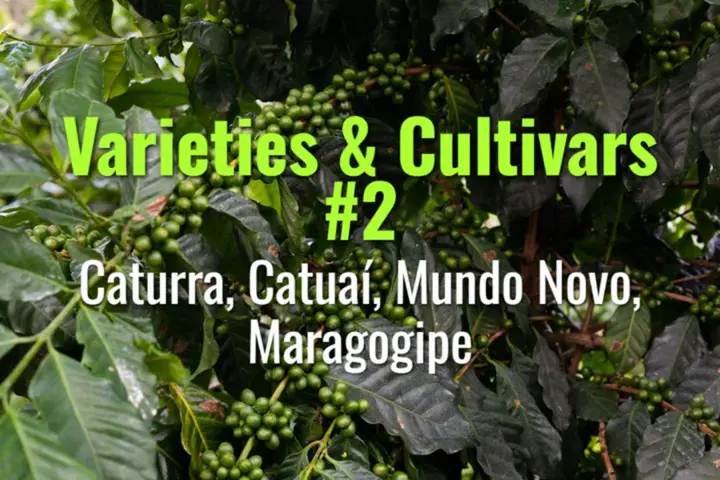Caturra, Catuaí, Mundo Novo, Maragogipe
This topic explores four key Arabica varieties—Caturra, Catuaí, Mundo Novo, and Maragogipe—their origins, traits, advantages, and roles in global coffee cultivation.
- Coffee Basics Nerds
- 2 min read
Article 2 of 12 in Varieties & Cultivars/

Caturra
- Origin: Natural mutation of Bourbon discovered in Brazil (Minas Gerais) in the early 20th century.
- Traits: Dwarf, compact growth; higher density planting possible.
- Yield: Higher productivity than Bourbon, early bearing.
- Flavor: Good balance, bright acidity, medium body.
- Weakness: Susceptible to coffee leaf rust and pests.
Catuaí
- Origin: Hybrid of Caturra × Mundo Novo, developed in Brazil in the 1940s.
- Traits: Compact size, adaptable to different elevations and climates.
- Colors: Exists in red (Catuaí Vermelho) and yellow (Catuaí Amarelo) forms.
- Yield: High yield, suitable for mechanized harvesting.
- Flavor: Balanced, clean, but generally less complex than heirloom varieties.
- Weakness: Requires careful management; disease vulnerability.
Mundo Novo
- Origin: Natural hybrid of Bourbon × Typica, discovered in Brazil (São Paulo, 1940s).
- Traits: Vigorous, tall plant; strong root system.
- Yield: High, resilient under diverse conditions.
- Flavor: Sweet, smooth, mild acidity.
- Importance: Widely cultivated in Brazil, forms basis for further hybridization.
Maragogipe (Maragogype)
- Origin: Mutation of Typica, discovered in Brazil (Bahia state, 1870s).
- Traits: Very large beans (“elephant beans”), elongated leaves, tall plants.
- Yield: Low; sensitive to climate and pests.
- Flavor: Floral, delicate, sometimes inconsistent; prized in specialty markets.
- Market role: Grown in Nicaragua, Mexico, and Central America in small quantities.
Comparative Notes
- Caturra: Compact, good for high-density planting, widely used in Latin America.
- Catuaí: Hybrid stability, adaptable, common in Brazil and Central America.
- Mundo Novo: Robust, high-yield, foundation variety for breeding.
- Maragogipe: Low-yield specialty, valued for unique bean size and niche flavor.
Lasting Importance
These four cultivars represent the innovation of 20th-century breeding:
- Caturra and Catuaí increased productivity.
- Mundo Novo offered resilience and strong yields.
- Maragogipe added specialty appeal through unique bean morphology.
Together, they shaped modern coffee agriculture, balancing yield, adaptability, and market diversity.